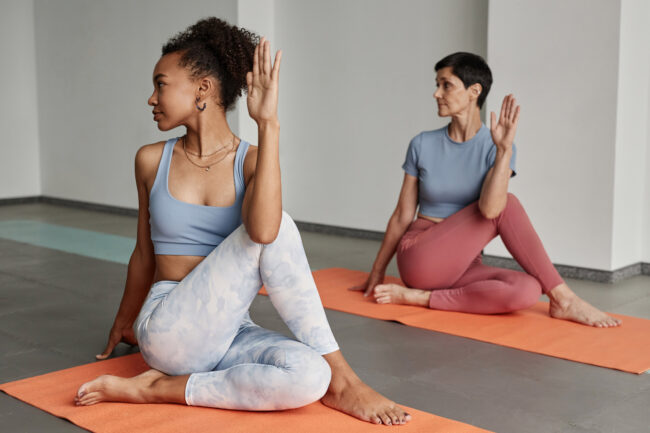
Learning how to improve mobility can boost your overall health and well-being, whether you’re aiming for better sports performance, bouncing back from an injury, or just wanting to improve overall movement.
In this guide, we’ll explore the various aspects of mobility and provide practical tips and exercises to improve mobility.
The Importance of Mobility in Health and Wellness
Mobility, essentially the ability to move freely and effortlessly, plays a vital role in maintaining good health and wellness. It includes joint mobility, muscle flexibility, and the coordination between them.
Good mobility aids in performing daily activities, from walking and climbing stairs to simple tasks like bending or reaching.
Poor mobility, on the other hand, can lead to a sedentary lifestyle, potentially causing weight gain, muscle weakness, and health issues such as cardiovascular diseases, diabetes, and obesity.
Stretching vs. Mobility Training
When improving mobility, it helps to know how to distinguish between stretching and mobility training. Both can enhance flexibility and joint mobility, but they differ in approach and benefits.
Stretching:
- Increases flexibility by elongating and lengthening muscles.
- Involves holding a specific position for a certain period to target a particular muscle or group of muscles.
- Static stretching, where you hold a stretch without movement, is a common form of stretching. It can help improve flexibility and range of motion.
- Is often used to improve muscle elasticity, reduce muscle tension, and alleviate stiffness.
Mobility Training:
- Emphasizes the ability to move freely and actively through a full range of motion at a joint.
- Targets joint mobility, stability, and control.
- May include exercises such as joint rotations, dynamic stretches, mobility drills, and proprioceptive exercises.
- Aims to enhance functional movement patterns, improve joint health, and optimize athletic performance.
- Often incorporates dynamic movements that mimic real-life activities or sports-specific movements.
While both stretching and mobility training are essential and complementary, stretching helps increase flexibility passively, while mobility training works on joint range of motion, stability, and control, vital for daily activities and sports.
Adding a few mobility exercises to your workout can reduce joint stiffness and make your movements feel smoother in your day-to-day life.
Mobility Exercises for Joint Health
Ready to get moving? Here’s a list of easy mobility exercises to help you stay flexible and active!
Note: These exercises should be performed gently and slowly, focusing on smooth movements and controlled breathing.
- Shoulder Circles: Stand or sit with your arms hanging by your sides. Slowly circle your shoulders forward for several repetitions, then reverse the motion and circle them backward.
- Neck Rotations: Gently turn your head to one side, bringing your chin toward your shoulder. Hold for a few seconds, then return to the center and repeat on the other side.
- Ankle Circles: Sit on a chair with your feet flat on the floor. Lift one foot off the ground and rotate your ankle in a circular motion, first clockwise and then counterclockwise. Repeat with the other foot.
- Hip Circles: Stand with your feet hip-width apart. Place your hands on your hips and circle them in a clockwise motion, then switch to counterclockwise.
- Wrist Flexibility: Extend your arm in front of you with your palm facing down. Use your other hand to gently press down on your fingertips, stretching your wrist. Hold for a few seconds, then switch to stretch the other wrist.
- Knee Flexion and Extension: Sit on the edge of a chair with your feet flat on the floor. Slowly straighten one leg out in front of you, then bend it back to the starting position. Repeat with the other leg.
- Spinal Twist: Sit on the floor with your legs extended in front of you. Cross one leg over the other and place the opposite elbow on the outside of the bent knee. Twist your torso toward the bent knee, feeling a stretch along the spine. Hold for a few seconds, then switch sides.
- Cat-Cow Stretch: Start on your hands and knees, with your wrists directly under your shoulders and your knees under your hips. Inhale as you arch your back and lift your head and tailbone toward the ceiling (Cow Pose). Exhale as you round your back and tuck your chin to your chest (Cat Pose). Repeat several times, flowing smoothly between the two poses.
- Thoracic Rotation: Lie on your side with your knees bent and arms extended in front of you. Keep your knees together as you rotate your upper body, reaching your top arm back as far as comfortable. Return to the starting position and repeat on the other side.
- Quad Stretch: Stand with one hand against a wall or chair for support. Bend one knee and grasp your ankle with the hand on the same side, bringing your heel toward your buttocks. Hold for a few seconds, then switch legs.
Remember: Consistency, patience, and celebrating achievements are key!
If for any reason you are having trouble or are especially worried about any joint problems or health issues, it’s a good idea to chat with a physical therapist before diving into a new exercise routine. We’re here to help!
Did you know you have Direct Access* to Physical Therapy? No referral, no problem!
Whether you’re a seasoned athlete or simply looking to move with more ease in your daily life, prioritizing joint mobility can truly make a difference in your overall health and wellness journey.
So, lace up those sneakers, roll out your yoga mat, or hit the gym floor—your joints will thank you for it!

















